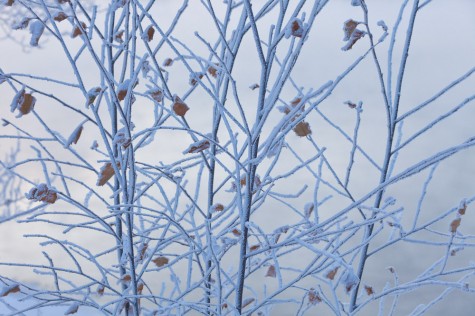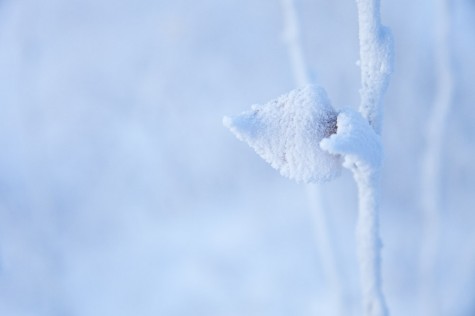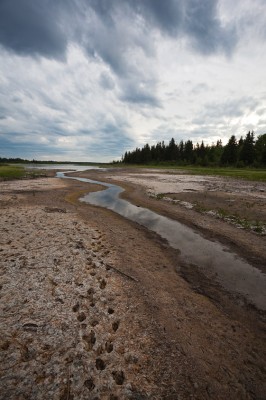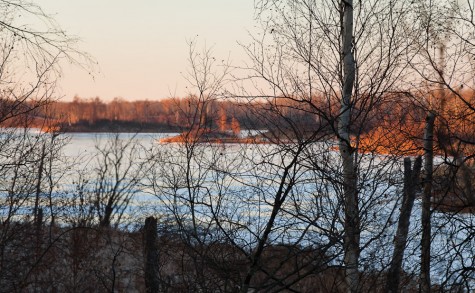Here’s another short video clip that I took during this recent period of extremely cold weather. Walking over the footbridge between Strathcona Science Park and Rundle Park, I was mesmerized by the combined, overlapping movement of the fog rising from the river, the ice flowing downstream, and the ripples in the water. The light breeze was moving the mist around and the low sun was glinting off the thin icebergs, creating a beautiful, swirling, shining scene.
|
||
|
After a heavy frost, even the most simple details can take on an extraordinary appearance. I made this photograph with a wide open aperture, and as close as possible to give a really narrow depth of field. This removes/blurs most of the finest details of the frost and dried grass blades, and concentrates the focus (no pun intended) of the image on the form, the sweep, of the grass. But, to me, the little bit of frost detail visible just along the narrow plane of focus, gives that extra little “spark” to the image. 
This past year I upgraded my camera to the Canon 5DmkII, it’s a terrific camera that I’m very happy with, and one of the neat tricks it does is shoot high definition video. I don’t shoot too much video—I’m a stills photographer at heart, regardless of what the camera can do—but it is fun to try once in a while. I took this short video this past week during the cold snap—it shows a small flock of Common Goldeneye (Bucephala clangula) ducks swimming in the river then taking off and flying, landing again a ways upriver. The ducks dive briefly under the water surface a couple of times before flying—my best guess is that they’re “de-icing” their wings (it was about -35° C that morning). You can push the fullscreen button (four outward arrows at the bottom-right of the video) to view it larger, or follow the link to watch a high-definition version at vimeo.com. 
Here’s another photo that I took last saturday during our cold snap. On really cold days I like to go make photographs at the Strathcona Science Provincial Park just east of Edmonton. Their is a warm water outflow a little upstream from the park which keeps the river partially open. The mist coming from the river coats the banks, and if the sun is out, the effect can be fantastic—and very chilly looking. 
That’s “cold” with a capital “C”. An arctic air front descended on the prairies, sending the temperature to extreme lows and sending all reasonable people safely indoors—the landscape photographers however, grab their cameras and head out. I find that when it gets below -30° C you can actually see how cold it is. The light is exceptionally clear, the frost on the grasses and shrubs accumulates and holds on tight, and the air seems to literally freeze—there is often an ice fog lying low to the ground, providing photographers a pale frosty blue/white background. If you’re well dressed, careful, and have a spare battery for your camera in your warm pocket (for when the first one freezes), it’s a beautiful time to be out capturing the landscape in a state that not many people get to experience. 
Recently, Dan Jurak, one of my favourite Edmonton-area photographers and blogger, published an image on his photo blog that reminded me so strongly of this photograph of mine taken this past summer, that at first I thought they could have been taken at the same place. It turns out it’s not the same location, but similar compositions and similar subject matter—Alberta’s lakeshores are turning to mudflats (and our mudflats are turning to grasslands). I took this photo at the Ministik Game Bird Sanctuary, near the location of the photo in another recent entry of mine, it’s a different lake, but the same trend. I like the moodiness of this photo, with the somewhat threatening sky and the animal footprints receding towards the remnant lake. 
Last week I took my camera (and my daughter) out to the Cooking Lake-Blackfoot Natural Area, about 30 min east of Edmonton, for an afternoon walk while the weather was still relatively mild. There has been just a dusting of snow so far this year, so the ice on the lake was bare and exposed to the quickly cooling air. As the sun moved lower in the sky and the temperature dropped the ice began to make terrific heaving, groaning and booming sounds. The frequency increased until there was nearly constant, resounding, echoing sound coming from the ice. Everything else was perfectly still, and the singing of the ice was the perfect background music while I took this quick photograph–just as the last sunlight made the bare aspen on the far shore glow a warm orange-red, in contrast to the cool blue of the shadowed lake ice in the foreground. 
|
||
|
Copyright © 2009-2025 Jonathan Martin-DeMoor |
||





